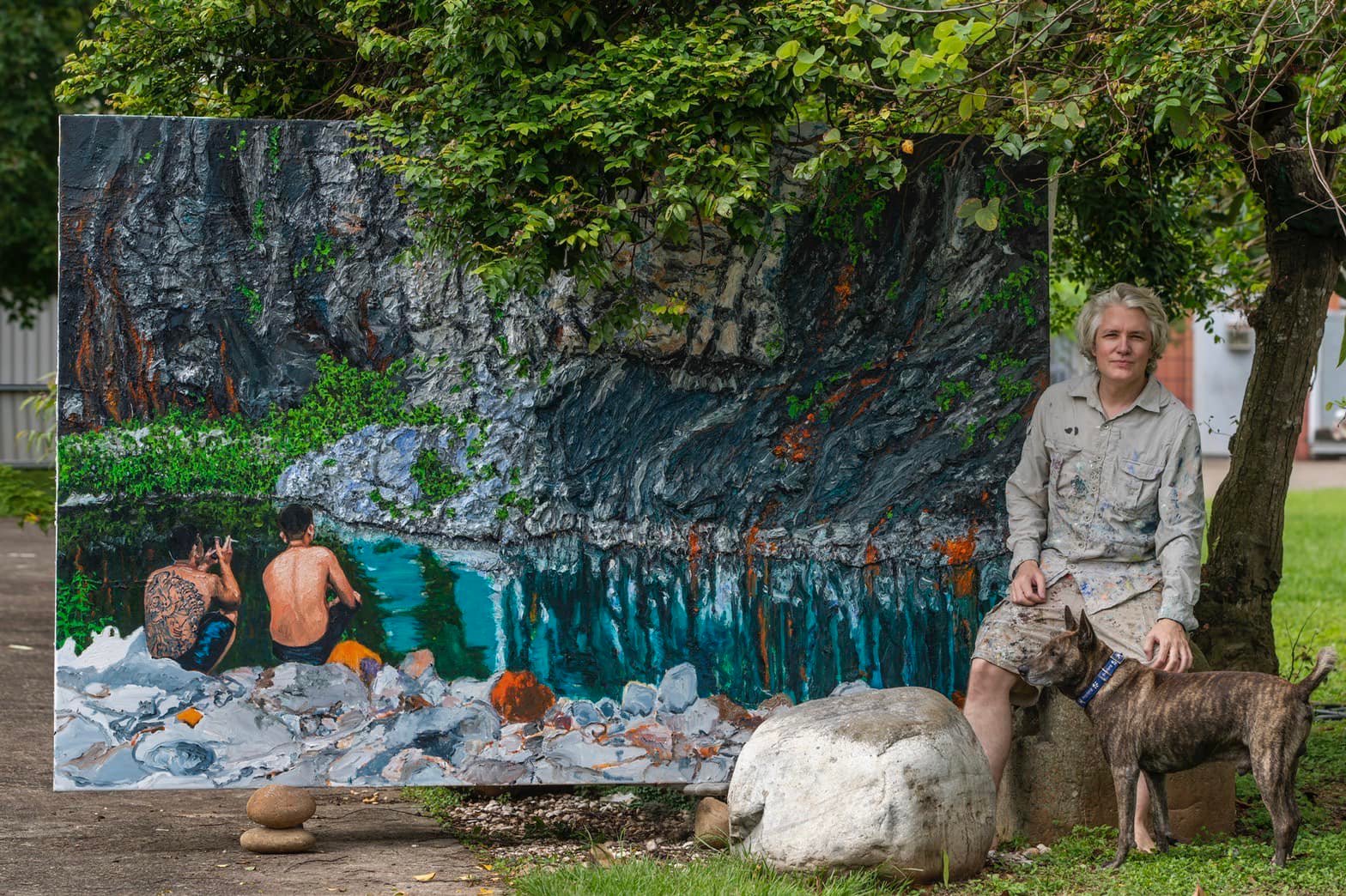
Daniel Pulman has learned about what it means to be lonely in aloof, distant cultural relations. He has been to many places around the world, worked in America, traveled through Asia, and lived recently in Taiwan under coincidental circumstances. As he moved from one place to another physically, Pulman has reflected on movement, from which the visual and auditory stimulations are both an exotic allure as well as a certain escape from reality. Gradually, from being an onlooker, he starts to project himself into his surrounding scenes. His gaze shifts from ordinary, monotonous everyday life to curious, arresting existences. A flâneur wandering, sojourning leisurely, he watches and appreciates stories unfolding in the streets, by a creek, or in the mountains, as he himself merges into the view as well.
This series of paintings are inspired by photographs taken randomly by Pulman during a trip to Guguan. The photographs feature common everyday scenes and people in Taiwan. As a tourist as well as an outsider, Pulman revisits the images imprinted in his mind and compares them to the photographs he has taken, examining the sights and things which people have taken for granted with a curious gaze. Adopting the approach and perspective of defamiliarization, he creates a natural reality that has never been seen before. To those who are familiar with the depicted environment, the paintings are suddenly rendered exotic. A spectator can even feel a sense of freedom in perceiving his hometown being transformed into another place. Pulman’s images convey a strong sense of realism, which departs from romanticism and moves away from pure sentimentalism. His expression of emotions is moderately reserved, and even shows a deliberate effort to seek balance between personal feelings and rationality. When he delineates a scene of friends or families playing together and having a joyful time, the emotion exuding from his image is condensed. The colors and light are solidified and fixed at the most suitable moment—the instant that he has enjoyed, and visualized into the image of his painting.
Pulman portrays the everyday landscape of Taiwan with realistic detail, and represents social living through history-making, tangible paintings of life. His painting touches the spectator’s heart with its realistic and tangible qualities of the images, which transport the spectator into the depicted scenes. However, his use of colors and the quasi-relief approach make prominent the three-dimensionality of the paint, and alter the stereotypical impression of painting as a two-dimensional art form. Such technique originates from Pulman’s experience of working as an assistant at the studio of Neo-expressionist artist Julian Schnabel when he was living in New York. The experience became a source of inspiration for the oil and mixed media painting, which he would develop later. In addition to his accurate delineation and embodiment of nature and contemporary life, Pulman throws away overly idealized imagination, replacing it with minute observation and depiction of appearances. From an observant outsider’s point of view, he portrays the emotions of people, while embedding his feelings in the scene, achieving a balance in the image that is characterized by both a sense of cool-mindedness as well as a slight release of emotions.
Pulman depicts in this painting series a group of young men with tattoos on their bodies having a leisurely time by a river and scenes of family excursions. By contrasting solid, warmthless mountains with the warmth of human emotions, the images reveal the artist’s contemplation on the distance between people, which is delineated in a way that sets the images apart from reality. He perceives the contradictions between reality and the state of mind, but holds onto his approach to portray nature and everyday life, an approach that prevents excessive emotional involvement in the scene and helps him stay reserved. However, since to exist is to be perceived, if one wants to understand this world, one must be able to produce knowledge through the full mediation of the body; and to understand how the world of appearances is perceived by the body, one has to start from the feelings of this flesh. An idea is itself an action of one’s will. Through such an action, the will is embodied or takes form. In particular, The Bathers of Guguan demonstrates fully Pulman’s mastery of impasto painting, which embodied his unique use of colors. Instead of “painting” a scenery on a flat canvas, he is “sculpting” the landscape with oil and mixed media on the two-dimensional surface. Consequently, even if it is a realistic depiction of landscape, it is only natural that the combination of the canvas and paint created by Pulman is different from that of other artists. He first perceives, analyzes and organizes the objective information received through sensory perception, and then utilizes his unique techniques to concretely express his natural subject. Because every individual comes from a different background, and understands things differently, which produces vastly divergent experiences. Difference of perspectives organized by the mind allows for utterly distinctive expressions of and approaches to an identical subject.
Pulman’s painting creates a theatrical effect, and even his depiction of realistic scenes gives off a dramatic tension, creating a kind of dialogue that gives ordinary everyday life a genuine sense of presence.